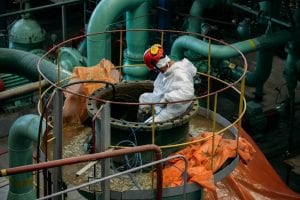How You Can Save Money on Tank Cleaning with Robots
Keeping industrial tanks clean is vital to keeping a chemical plant functioning properly. The process of removing sludge hasn’t changed much in decades, but the tools that are used to do it have. It’s a dirty and dangerous process that can be potentially harmful to employees who spend time in these tanks.
In 2020, many plants are still using human crews to clean these dangerous, confined spaces, but there is another safer, less expensive option. Innovation has arrived on the scene: the robotic tank cleaner. Tank-cleaning robots replace the need for human cleaning crews which saves time, money and protects your employees’ health and safety.
Let’s discuss more how ecobots can improve your tank cleaning process and bring your plant into the 21st century.
Case Study: See how much this chemical plant saved by going with robotic tank cleaning. View

What is a Tank-Cleaning Robot?
A robotic cleaning system (RCS) uses visual programming language to clean industrial tanks. They are built to entirely replace the need for human crews.
These ecobots use an electric-over-hydraulic system that includes an articulating arm for wash down and another with an attached vacuum head for material removal. They can be controlled by employees remotely to remove the need to enter into hazardous environments or confined spaces.
The RCS moves a massive amount of material quickly, at rates up to 150 bbls/hr with an internal tank reach of 150 feet. The robots used in tank cleaning can access entryways that are as small as 24 inches. The system pumps are capable of delivering 60 gals/min at 1250 psi.
So Operators can see what is happening, the RCS uses a Class 1 Division 1 lighting and camera system. The entire system is contained in a 40-foot shipping container and requires about two hours to prepare for use.
Pros of Using Robots over Humans for Tank Cleaning
Plant managers who turn to an RCS to clean industry tanks quickly see the benefits. Tank-cleaning robots are safer, less expensive, and greener than using human cleaning crews.
When you turn to a tank-cleaning robot, your human crew does not have to climb into confined spaces. Tanks often have access doors that are no more than 24 inches in diameter, which can be difficult to exit if an emergency arises.
Robots are very cost competitive with conventional cleaning methods. In high solids environments, the robotic system is far more efficient and less costly than using human crews. They do not use as much water or create as much waste as human crews, so the job gets done quicker, more efficiently, and with considerably less environmental impact than conventional methods.
How You Can Save Money with Robotic Tank Cleaning
If you are an operations, maintenance, or plant manager who has been tasked with increasing efficiency and saving money, then you should investigate how robotic tank-cleaning will help your plant. These are several of the ways that using an RCS will help you maximize your budget:
Avoid Contamination
When you use an ecobot, you save money on the chemicals needed to complete the job. Ecobots do not need to wear safety gear and don’t require safety training.
Instead, operators use a chlorine solution to decontaminate the robots before they enter the tanks. The robots don’t bring any dirt or grime into the tanks, they just clean the sediment and sludge.
Remove Human Crews
The number one benefit of ecobots is the removal of human crews entering dangerous confined space. Plant management is always looking for ways to improve employee safety, and using a robotics systems does it. No human needs to enter the toxic tank.
And:
No human needs to step away from their day job to clean the industrial tanks. Ecobots do not need breaks, sick days, or vacation time.
Plants that still rely on humans to clean tanks have to be sure the tanks are safe before crews enter them. With the RCS this step can be skipped, which saves money and time. Ecobots also remove the risk of human error, which can be expensive and time-consuming.
Avoid Downtime
Ecobots help keep plants up and running. When employees have to step away from their jobs to clean tanks, their jobs aren’t being done and the tanks cannot be used.
Sometimes, this process can take several days, and even weeks. Plant productivity suffers and revenue decreases. Supplies aren’t being used, and money is being spent, not made.
Plant Managers become heroes when they find a solution that not only saves money but increases employee safety. Using tank-cleaning robots saves money, time, and safety issues. The time is now to turn to ecobot technology to clean your industrial tanks.






